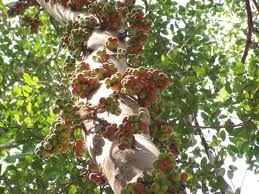Prof. Cao Kunfang and his team of XTBG have used the genus Ficus for conducting ecophysiological comparative studies and for interpreting the adaptive significance of plant hemiepiphytism in tropical rainforests over the past years. Their previous studies conducted on adult trees grown in a common garden found substantial differentiation in functional traits related to both water and light responses between hemiepiphytic Ficus specie (Hs) and non-hemiepiphytic Ficus species (NHs). Even greater differences are likely to occur for juveniles between the two growth forms, which experience contrasting environmental conditions when establishing under natural conditions.
Using three Hs (Ficus concinna, Ficus tinctoria and Ficus virens) and three NHs (Ficus hispida, Ficus racemosa and Ficus semicordata) grown under different irradiance levels, the researchers conducted detailed tests of Hs and NHs in seedling ecophysiology. They tested whether irradiance played an important role in niche differentiation (canopy vs. ground) between Hs and NHs and evaluated the potential interactions between water and light in determining environmental adaptations of Ficus seedlings.
They hypothesized that Hs and NHs were different in response to different growth irradiance during juvenile stage, with Hs showing characteristics of higher irradiance requirement. They further hypothesized that in Hs more conservative water use and stronger drought tolerance that are crucial for canopy regeneration have restricted their photosynthetic assimilation and growth under favorable water conditions. Contrastingly, in NHs the more prodigal water use would be related to higher growth and competitiveness but lower drought tolerance.
Their study was not consistent with the conventional ‘light’ hypothesis for hemiepiphytic life form adaptation; seedlings of both Hs and NHs showed characteristics of high light requirement. However, Hs and NHs seedlings showed contrasting characteristics in growth, leaf water use and resistance to drought.
The study entitled “Is hemiepiphytism an adaptation to high irradiance? Testing seedling responses to light levels and drought in hemiepiphytic and non-hemiepiphytic Ficus” has been published online in Physiologia Plantarum, DOI: 10.1111/j.1399-3054.2012.01694.x

Ficus racemosa (Image by HAO Guangyou)

